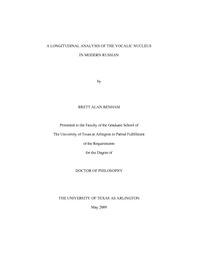
ATTENTION: The works hosted here are being migrated to a new repository that will consolidate resources, improve discoverability, and better show UTA's research impact on the global community. We will update authors as the migration progresses. Please see MavMatrix for more information.
Show simple item record
| dc.contributor.author | Benham, Brett Alan | en_US |
| dc.date.accessioned | 2009-09-16T18:18:41Z | |
| dc.date.available | 2009-09-16T18:18:41Z | |
| dc.date.issued | 2009-09-16T18:18:41Z | |
| dc.date.submitted | January 2009 | en_US |
| dc.identifier.other | DISS-10261 | en_US |
| dc.identifier.uri | http://hdl.handle.net/10106/1701 | |
| dc.description.abstract | This instrumental acoustic study investigates coarticulation as the source of palatalization in Modern Standard Russian. This study posits that the nucleus is bifurcated, with nodes for a pre-kernel and a kernel. At the initial edge of a stressed vowel, coarticulation between the pre-kernel and the kernel creates the distinctive onset, attributed to preceding palatalized environments. At the terminal edge of a stressed vowel, coarticulation between the kernel and the next vocalic segment (the offglide, or the pre-kernel of the following syllable) creates the distinctive offset, attributed to following palatalized environments. In unstressed syllables, the kernel vowel is deleted, and the nucleus adopts its vocalic identity from the surviving pre-kernel. In Modern Standard Russian, the pre-kernel's sphere of influence originates during the consonant onset, and considerations for the pre-kernel's articulatory requirements take precedence over the vocalic kernel's and semi-vocalic offglide's requirements. In turn, the requirements of the offglide take precedence over the kernel. In stressed syllables, the kernel forms diphthongal and triphthongal coarticulations due to the tractive force of the surrounding vocalic nodes. In unstressed syllables, the surviving pre-kernel forms coarticulations with the surrounding vocalic nodes. In this study, formant measurements taken at regular intervals across the duration of a syllable are modeled by mathematical equations, to identify change-points, which collectively represent the behavior of the syllable as a whole. Comparisons of the change-points of systems of syllables indicate that the acoustic behavior of syllables in connected speech must be categorized into more classifications than are permitted by the conventional binary contrast, which arises from a feature within the phonemic system, creating only two classes of consonants: soft vs. hard. This study reveals that coarticulation with the segment /j/ in the pre-kernel node of the nucleus is the primary source of effects attributed to palatalization. Furthermore, additional coarticulation effects occur, for virtually every pairing of adjacent contrastive specified vocalic targets. The number of possible coarticulated combinations is decreased by phonological processes that cause vowel reduction. In Modern Standard Russian, coarticulation routinely occurs across an intervening consonant interlude, but may also occur across an intervening contrastive vowel in rare cases. | en_US |
| dc.description.sponsorship | Silva, David J. | en_US |
| dc.language.iso | EN | en_US |
| dc.publisher | Linguistics | en_US |
| dc.title | A Longitudinal Analysis Of The Vocalic Nucleus In Modern Russian | en_US |
| dc.type | Ph.D. | en_US |
| dc.contributor.committeeChair | Silva, David J. | en_US |
| dc.degree.department | Linguistics | en_US |
| dc.degree.discipline | Linguistics | en_US |
| dc.degree.grantor | University of Texas at Arlington | en_US |
| dc.degree.level | doctoral | en_US |
| dc.degree.name | Ph.D. | en_US |
| dc.identifier.externalLink | http://www.uta.edu/ra/real/editprofile.php?onlyview=1&pid=1554 | |
| dc.identifier.externalLinkDescription | Link to Research Profiles | |
Files in this item
- Name:
- Benham_uta_2502D_10261.pdf
- Size:
- 10.40Mb
- Format:
- PDF
- Name:
- BenhamDissData.zip
- Size:
- 1.300Mb
- Format:
- Unknown
This item appears in the following Collection(s)
Show simple item record


